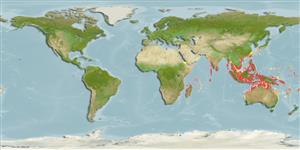Actinopterígios (peces con aletas radiadas) >
Scorpaeniformes (Scorpionfishes and flatheads) >
Tetrarogidae (Wasp fishes)
Etymology: Vespicula: Latin, diminutive, vespa = wasp (Ref. 45335).
Medioambiente / Clima / Gama
Ecología
; marino; salobre demersal. Tropical, preferred ?
Indo-West Pacific: Mergui Archipelago (Myanmar) eastward to the Philippines and Sulawesi; including Hainan Island, China.
Tamaño / Peso / Age
Maturity: Lm ? range ? - ? cm
Max length : 5.8 cm SL macho / no sexado; (Ref. 39597)
Short description
Morfología | Morfometría
Espinas dorsales (total): 13 - 16; Espinas anales 3. Dorsal with anterior 3 dorsal-spines forming a nearly separate fin; soft rays 3.5-5.5. Anal soft rays3.5-4.5. Orbit 6-9% SL.
Apparently occurs over soft sand and broken shell bottoms. Of little commercial interest and seem to be marketed fresh (Ref. 39597).
Life cycle and mating behavior
Madurez | Reproducción | Puesta | Huevos | Fecundidad | Larva
Poss, S.G., 1999. Scorpaenidae. Scorpionfishes (also, lionfishes, rockfishes, stingfishes, stonefishes, and waspfishes). p. 2291-2352. In K.E. Carpenter and V.H. Niem (eds.) FAO species identification guide for fishery purposes. The living marine resources of the Western Central Pacific. Vol. 4. Bony fishes part 2 (Mugilidae to Carangidae). Rome, FAO. 2069-2790 p. (Ref. 39597)
IUCN Red List Status (Ref. 115185)
CITES (Ref. 94142)
Not Evaluated
Threat to humans
Harmless
Human uses
Más información
Age/SizeCrecimientoLength-weightLength-lengthLength-frequenciesMorfometríaMorfologíaLarvaDinámica larvariaReclutamientoAbundancia
ReferenciasAcuiculturaPerfil de acuiculturaRazasGenéticaFrecuencias de alelosheritabilidadEnfermedadesProcesamientoMass conversion
ColaboradoresImágenesStamps, CoinsSonidosCiguateraVelocidadTipo de nataciónSuperficie branquialOtolitosCerebrosVisión
Herramientas
Special reports
Download XML
Fuentes de Internet
